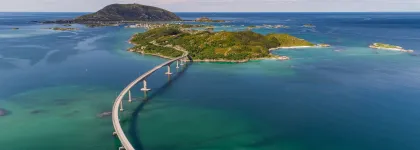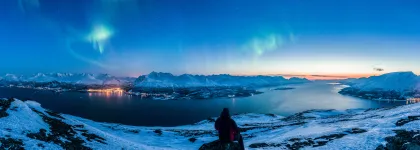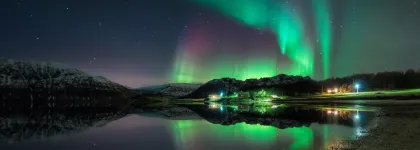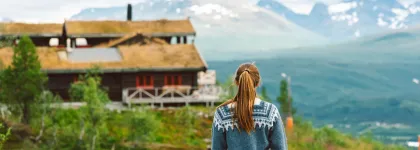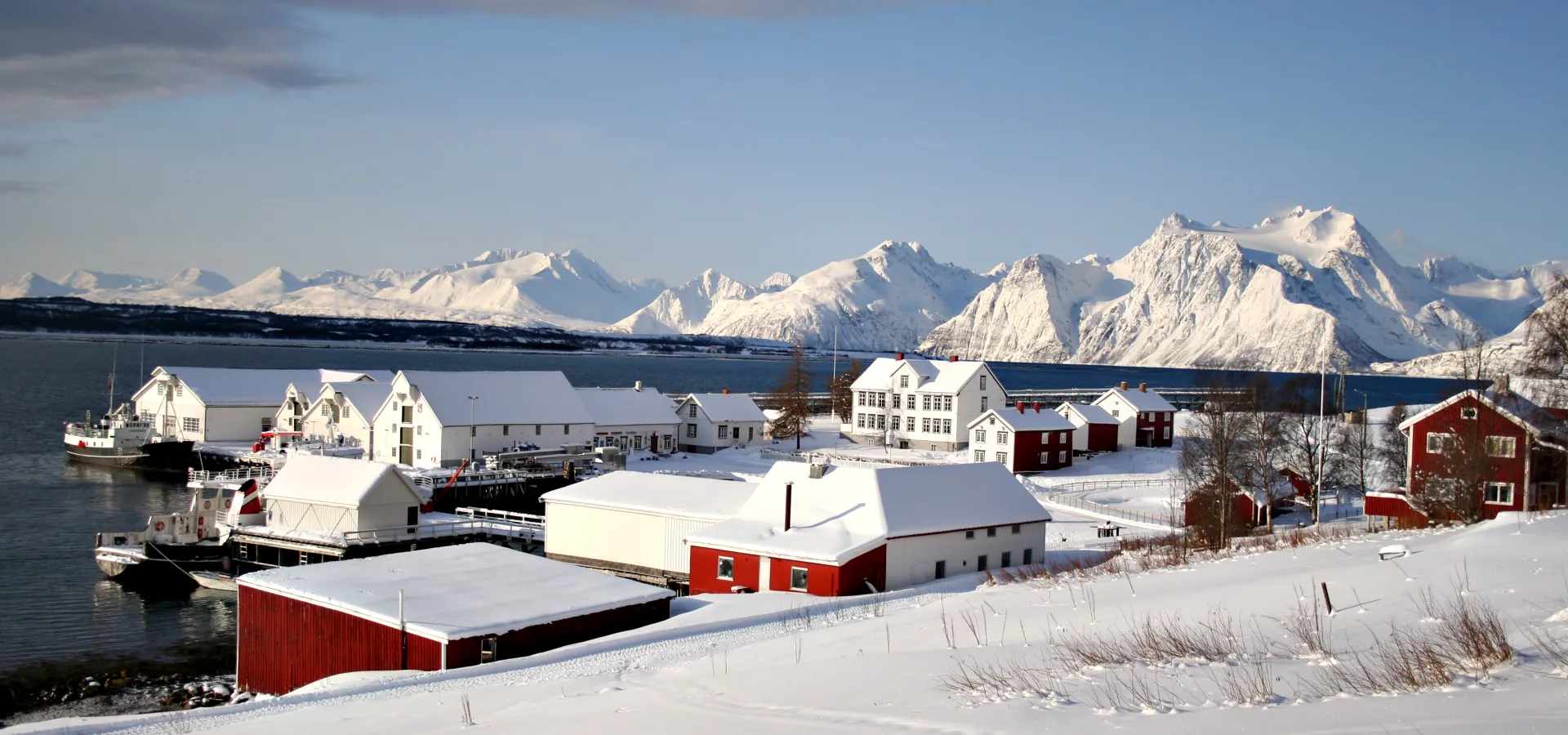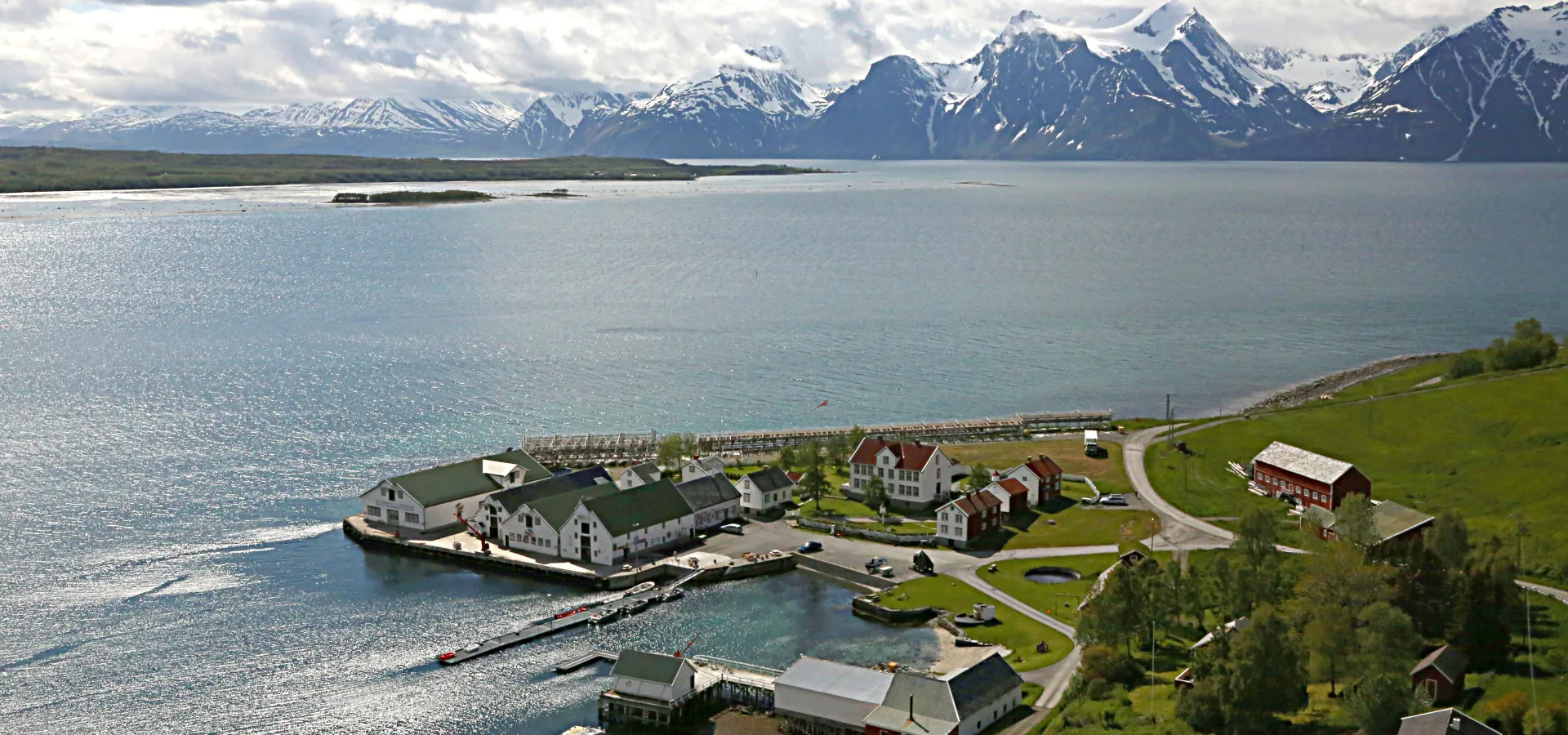Havnnes is a well-preserved, listed 19th century trading post, situated in the midst of some of the most stunning scenery in all of Northern Norway. Forget opening hours and guided tours: Havnnes is no museum but a working community!
By the inlet under the Lyngen Alps
You can see it already on the short ferry crossing over the Rotsundet inlet: Havnnes, with its old, white-painted houses, seems to float above the water there on its low headland, girdled by hayfields and green forests. The 1,500 metre (4,921 ft) high peaks and the glaciers of the Lyngen Alps form a wild and ruggedly beautiful backdrop. The 10-minute ferry trip to this, the most northerly working trading post in all of Norway, is a detour from the E6 and offers a rich mix of cultural history, the everyday lives of coastal people, and fantastic views.
Preserved trading post
“Storgården”, the elegant main house, was erected in 1850-60 and takes pride of place in the midst of the cluster of buildings, with its garden in front complete with dovecote. The buildings are painted white on the sides facing the water, and red on the sides facing the forest. Red paint was cheaper than white, and was good enough in places no-one would see, while the more exclusive white paint was used to impress visitors arriving by ship from the inlet. And yet Havnnes is no museum – the local people frequent the general store, the children play along the quayside, forklift trucks drive pallets filled with stockfish, and the fishing boats make regular calls.
Many small buildings
“Jomfruburet” (The Maidens’ Bower) dating from the 1700s, is the trading post’s oldest house. This was where the older, unmarried ladies of the family lived. Almost as old is “Bårstua”, or “Borgerstua”. Running a trading post with an inn and trading rights involved many obligations, including keeping a “borgerstue” (travellers’ accommodation) ready for fishermen, ships’ crews and passengers on their way north or south past Havnnes. One of the buildings, known as “Banken” (The Bank), dates from the 1850s; after 1900 it became the head office of the savings bank Skjærvø Sparebank.
The general store and summer café
The general store, dating from 1916, is still a working establishment. Decorated with vintage tin signs, there are advertisements for everything from soap to coffee. Tobacco and beer advertising is more of a problem these days. “Ta et glass øl, De også” (“Why not enjoy a glass of beer?”) is of course prohibited alcohol advertising, but with a special licence the owners are allowed to hang it there. The advertisements for “sanitary products” in anonymous packaging (yes, it is what you thought), would, on the other hand, have been more explicit today.
Stockfish
Stockfish (unsalted, dried fish, usually cod) is Norway’s oldest export product, and Havnnes Handelssted traditionally always bought its stockfish directly from the fishermen. When the fishermen stopped drying the fish themselves, Havnnes Handelssted began its own stockfish production, and now visitors can go into the stockfish warehouse and see the big piles of fish destined for the Italian market. Salted fish is also produced here.
6,000 years of history
In the forest above Havnnes a large collection of spear- and arrowheads has been found, some of them made from stone imported from the Kola Peninsula up in the far north. There appears to have been some sort of mass production of stone tools going on here, which has surprised the archaeologists. Up until the 17th century, Sami culture was more or less dominant in the area, but after that period Norwegians and Danes started to settle along the Rotsundet inlet.
Trading post
Havnnes is situated on a headland at the entrance to the Rotsundet inlet, and from here one can sail into the Lyngenfjord, along the shipping channel that goes south towards Tromsø and north towards Skjervøy and Finnmark. In 1784, Havnnes was awarded an innkeeping licence, in other words a licence to conduct trade. The Giæver family came to Havnnes in 1795, and they have run the place ever since, among the fish dealers, shop-owners, big farm-owners, fishing boat owners, industrial entrepreneurs and bankers. Today, Havnnes is run by the seventh generation of the Giæver family.
Mother Lyng
Among the more well-known members of the Giæver family was “Mor Lyng” (Mother Lyng), who ran Havnnes early in the 1800s. She gave birth to 12 children, all of whom died. So she fostered as many as 32 orphans, and made sure they were taught their parents’ trade: seaman, fisherman, farmer, etc. Her care and compassion for the poor was legendary. She died in 1845.
…daher nicht zerstören…
Towards the end of 1944, the population was forcibly evacuated and the houses razed to the ground by the German occupying forces retreating from Northern Troms and Finnmark. The Giæver family went to Trondheim, where they lived for a long time not knowing what had happened to Havnnes. In the spring of 1945, the then owner, Johs. Giæver, returned to Havnnes and found the place untouched. He also found a notice written on cellulose which read “Kulturell wertvoll, daher nicht zerstören” (“Of cultural value, do not destroy”). The cellulose notice has been framed and now hangs in the general store.
Visits to Havnnes
Olavrosa, an recognised list of Norwegian heritage, lists Havnnes. Havnnes is easy to see from the E6. However, the ferry over Rotsundet has few departures daily, so you are advised to plan a little. Since the road network on the island of Uløya is limited, it is a good idea to leave the car on the mainland. There are cycles and boats for hire at Havnnes, and there are marked walking trails, including easy woodland walks and more demanding mountain hikes. You will find information at the general store. The main house is privately owned, while the smaller houses round about are let as tourist accommodation. The general store and summer café are open to everyone, and there is no problem getting about on one’s own. Visit Havnnes Handelssted’s own website www.giaever.net for information about Havnnes.



